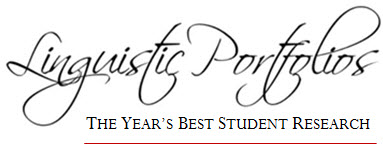
Abstract
A central goal of linguistics is to develop models to account for how children acquire their native language. One study that has done this is Boersma, Escudero, and Hayes (2003). In this study, the authors developed a model using an Optimality Theoretic approach to account for the ways in which children acquire language and language specific F1 frequencies into phonetic categories. The model uses a set of Optimality Theoretic constraints whose rankings gradually change in response to the learner’s input. The way this model works, however, utilizes highranked discriminatory constraints in the initial state to produce movement in the Optimality Theory hierarchy. By taking this approach, it seems that the learner initially perceives incoming speech sounds as non-speech sounds and soon thereafter learns to categorize the sounds into the appropriate phonetic categories, resulting in language acquisition. In this paper, I have modified the proposal of Boersma, Escudero, and Hayes (2003) to avoid the counter-intuitive implications of perceiving incoming speech sounds as non-speech sounds. Instead of using high-ranked discriminatory constraints in the initial state, I have reversed the model to use high-ranked “perceive” constraints in the initial state. Reversal of the initial state is attractive because it no longer assumes that children inherently do not acknowledge speech sounds at the beginning of language acquisition. This paper gives an alternative perspective on this language acquisition model and is designed to explore different ways to account for how the infant brain acquires language at the phonetic level. Additionally, the current model also acknowledges frequencies that are not present in the training data where the previous model categorizes unfamiliar frequencies as non-speech sounds.
Creative Commons License

This work is licensed under a Creative Commons Attribution-NonCommercial-No Derivative Works 4.0 International License.
Faculty Supervisor
Dr. Timothy Hunter
Recommended Citation
Feehan, Colette
(2016)
"An Optimaility Theoretic Approach to Child Language Acquisition,"
Linguistic Portfolios: Vol. 5, Article 3.
Available at:
https://repository.stcloudstate.edu/stcloud_ling/vol5/iss1/3



Author Bio
Colette Feehan is now a graduate student in general linguistics at Indiana University. She worked on this paper for her undergraduate honors thesis at the University of Minnesota, Twin Cities. Since completing her BA in linguistics and psychology at Minnesota she spent a year working in the Speech Acquisition Lab at the University of Utah and has now begun her Ph.D. at Indiana University with a focus on second language phonetics and phonology. She can be reached at: feeh0017@umn.edu.